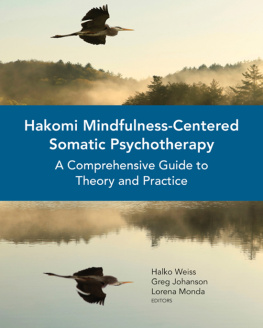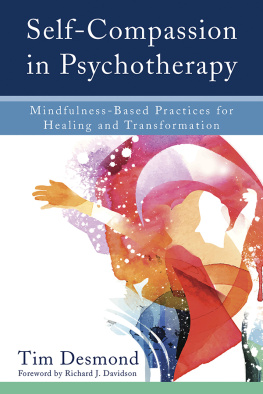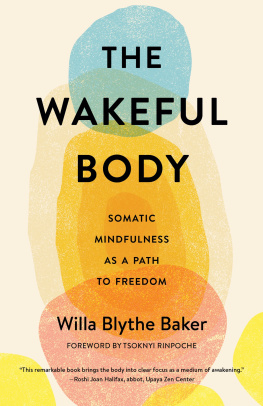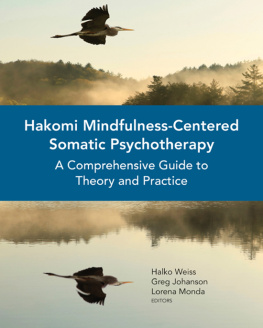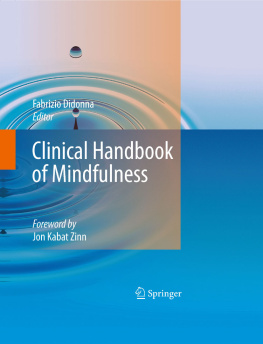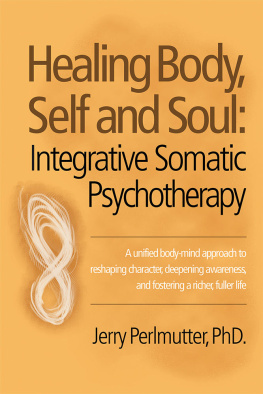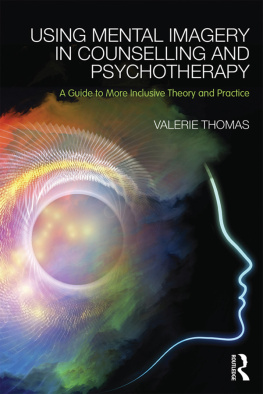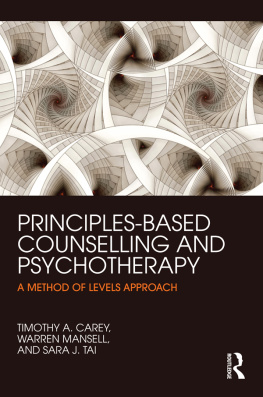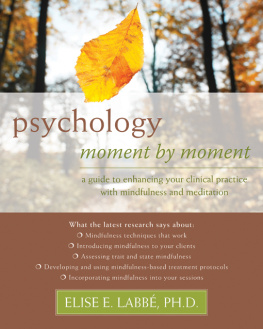
Hakomi
Mindfulness-Centered
Somatic Psychotherapy
A Comprehensive Guide to
Theory and Practice
Halko Weiss, Greg Johanson, and Lorena Monda
EDITORS

W. W. Norton & Company
New York London
A NORTON PROFESSIONAL BOOK
Copyright 2015 by Hakomi Institute, Halko Weiss,
Greg Johanson, Lorena Monda, and Manuela Mischke Reeds
All rights reserved
First Edition
For information about permission to reproduce
selections from this book, write to Permissions,
W. W. Norton & Company, Inc., 500 Fifth Avenue
New York, NY 10110
For information about special discounts for bulk
purchases, please contact W. W. Norton Special Sales at
specialsales@wwnorton.com or 800-233-4830
Production manager: Christine Critelli
Library of Congress Cataloging-in-Publication Data
Hakomi
mindfulness-centered somatic psychotherapy : a comprehensive
guide to theoryand practice / edited by Halko Weiss, Greg
Johanson, and Lorena Monda.
pages cm
Includes bibliographical references and index.
ISBN 978-0-393-71072-4 (pbk. : alk. paper)
1. Mind and body therapies. 2. Psychotherapy. I. Weiss,
Halko, 1947
RC489.M53H353 2015
616.89'14dc23
2015012076
W. W. Norton & Company, Inc.
500 Fifth Avenue, New York, N.Y. 10110
www.wwnorton.com
W. W. Norton & Company Ltd., Castle House, 75/76 Wells
Street, London W1T 3QT

MINDFULNESS HAS GONE viral. Open any psychotherapy journal or conference brochure and you will likely find something with mindfulness in the title. So pervasive is this trend that an issue of Psychotherapy Networker magazine was dedicated to the mindfulness explosion. Its hard to remember when the term mindfulness entered the vernacular of psychotherapy, but in recent years it has spread to every therapeutic modality, many of which now allege to be mindfulness-based, simply to establish land rights on this fruitful turf. But, in 1980, when the Hakomi Institute was formed, only Buddhists and forward-thinking physicians training in Jon Kabat-Zinns mindfulness-based stress reduction knew the term.
Now, with enough publications on the subject to fill a virtual warehouse, one wonders, What more can be said? While many authors cite growing evidence that a regular mindfulness practice can regulate emotions, increase happiness, and inoculate against stress, few describe how mindfulness can promote deep characterological transformation. As pioneers in the use of mindfulness in psychodynamic therapy, Hakomi therapists do just that.
Hakomi is a form of guided self-study that uses mindfulness to access the memory system where our most fundamental, wide-reaching beliefs are implicitly encoded. These beliefs, which lie below the level of conscious choosing, condition our perceptions and responses to all aspects of life. New research suggests that we can reshape our neural hardware and shift these organizers of experience through the function of attention. This book will show you how.
Hakomi began with one mans vision, found its name in another mans dream (see Appendix 3) and was refined and expanded upon by a cadre of passionate pilgrims who set forth on a journey that has spanned five continents and three decades. Thousands of practitioners now make their living using Hakomi, as trainers and therapists, so why isnt our approach better known?
Like many indigenous teachings, Hakomi has been transmitted to clients and practitioners who are drawn to our purported willingness to welcome rather than reject the qualities that make us most human: vulnerability, uncertainty, contradiction, and pain. Our guiding mantrapause and study, rather than fixis a balm for road-weary seekers of healing and personal growth, who have attempted to eliminate rather than befriend their troublesome parts.
It sounds counterintuitive, but Carl Rogers once said, The curious paradox is that when I accept myself just as I am, then I can change. He was echoing Lao-tzu, who some 2,600 years earlier wrote in more poetic terms: If you want to shrink something, you must first allow it to expand. If you want to get rid of something, you must first allow it to flourish. If you want to take something, you must first allow it to be given. This is called the subtle perception of the way things are.
Hakomi integrates the perennial wisdom of Buddhism and Taoism with modern scientific findings on how the brain changes itself through experience rather than reflection. It also balances the aware and compassionate qualities of larger self-states with the realities of the historically conditioned ego. Simply put, our knowledge often outpaces our readiness to put this knowledge into practice, and our self-acceptance can be obscured by feelings of unworthiness.
Hakomi is at once idealistic in its belief that humans have the capacity to be aware of themselves and, therefore, less bound by their automatic reactions; and simultaneously realistic, in that we accept that it takes time and a particular attitude and state of consciousness to do so. This attitude requires going beyond judgment, toward understanding and integration, since the war on self is clearly not working. Instead of polarizing against the parts of the self that seem to sabotage our happiness, we may need to befriend all parts, especially the most difficult and intractable.
The first step is to slow down and turn inward in a calm and curious way. Admittedly, step one may be a hurdle for those of us who function at Mach speed or prefer to turn away from or, worse, eliminate the parts of ourselves that give us trouble. Whats more, our species has never been great at relaxing into and embracing discomfort. Our preference for anesthetizing ourselves via distraction, or sidestepping rather than encountering difficult experience, is legendary.
Second, we must suspend attachment to what we think we already know, choosing instead to learn from the pregnant mystery of the not-yet-named aspects of our felt experience. This requires exploring the many realms of our existence instead of granting favor to cognition. For too long, under the sway of our Cartesian heritage, we have attempted to know ourselves by splitting wholes into parts, focusing more on our thoughts than our feelings and bodies. However, as Rob Fisher asserts in the section that follows, People are adept at using words to dissemble, but the body is far more direct in communicating our inner states to those who are willing to listen.
Fortunately, the tides are beginning to turn: As we move into what might be termed the age of integration, many people are beginning to appreciate that the part can only be informed by the whole. This integrative ontology is the crux of Hakomi, whose principles of mind-body holism and unity acknowledge our multiply determined selves and the larger context within which they relate.
Consistent with our integrative approach, this book is a symphony of voices rather than a solo composition. Since differentiation promotes integration, several members of the Hakomi faculty have coauthored this book. Some writers have chosen to explore the tail, others the trunk of the Hakomi method, each trying to provide as good an understanding as words on a page can give of the felt sense of this experiential approach.
We began soliciting submissions in 2005, and then bit our knuckles as more books on mindfulness and psychotherapy hit the shelves. To quiet our anxiety, we reminded ourselves that to know oneself requires slowing down and trusting the intrinsic readiness to move forward. Now, after nearly 10 years of reflective writing about thirty-plus years of clinical and training experience, we are ready to move Hakomi into the forefront of the mindfulness explosion, by showcasing our considerable expertise on core-level change. Toward this end, we offer readers a guide to our unique mindfulness-centered, somatic approach with plentiful references to the mainline literature in psychology and counseling.
Next page
